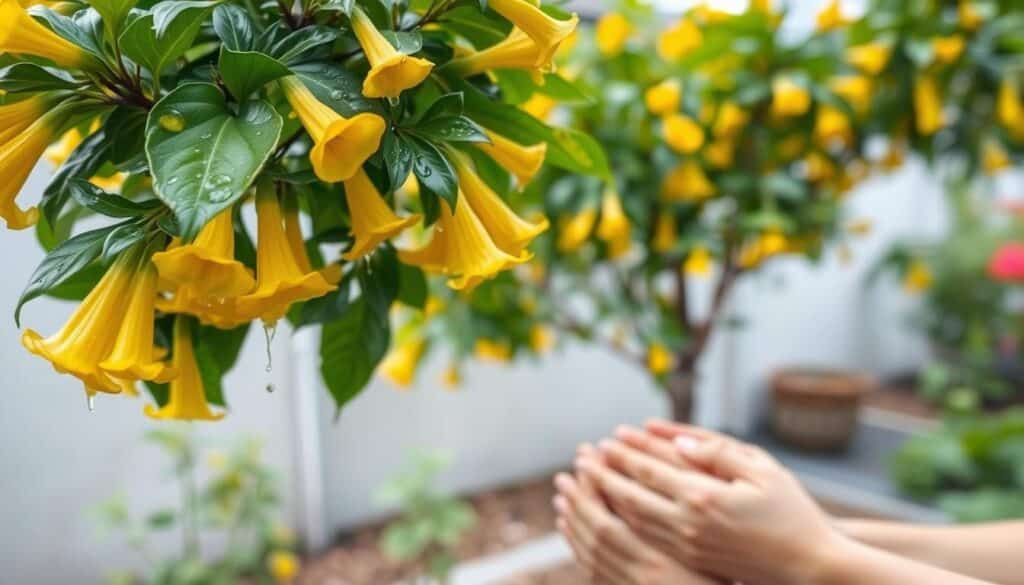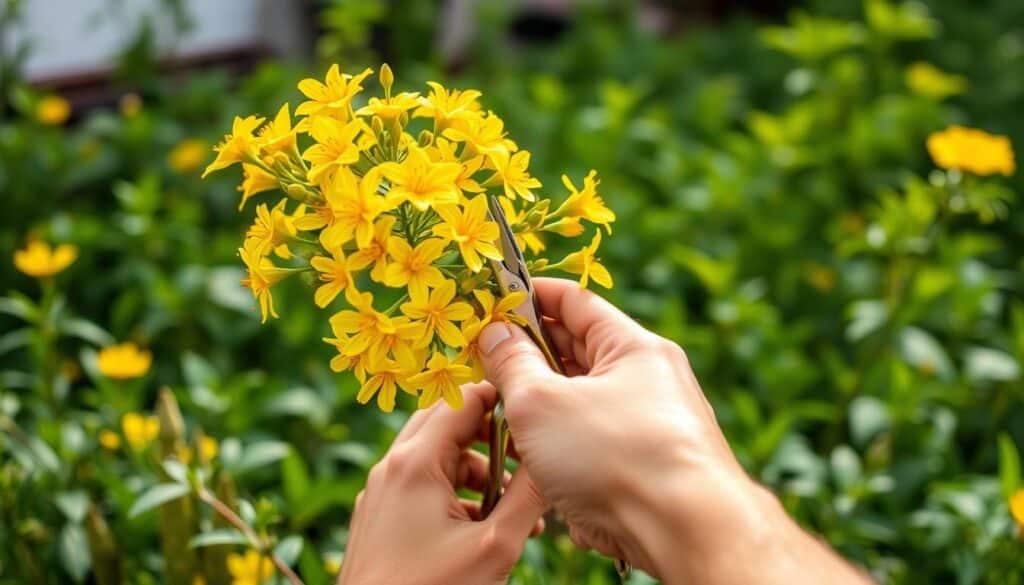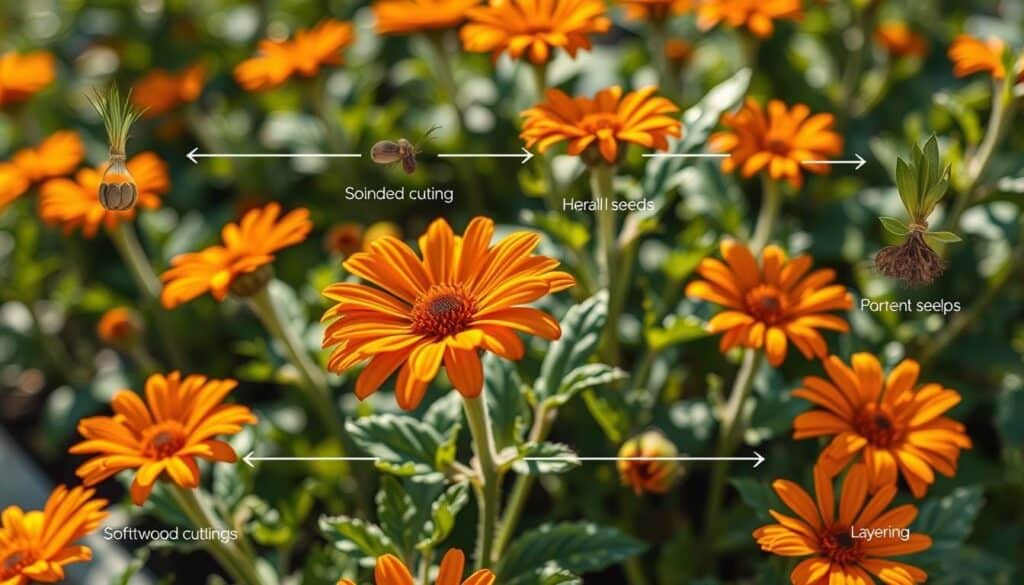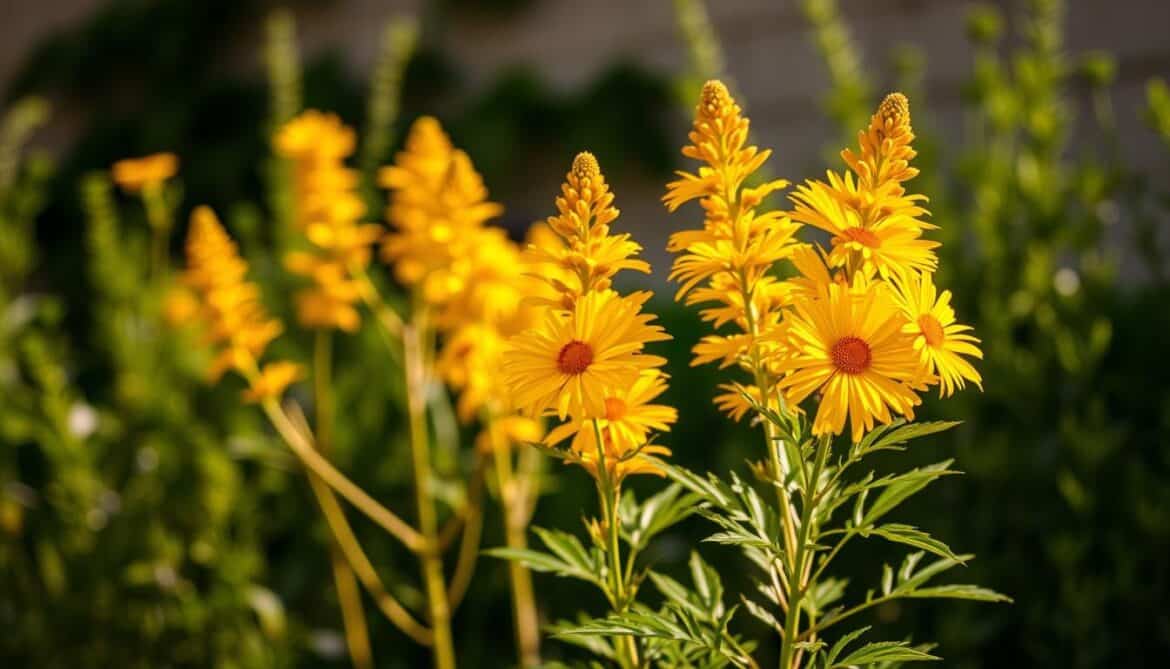Imagine a burst of golden sunshine in your backyard, even on the hottest summer days. That’s what the esperanza plant brings—a lively shrub that turns ordinary gardens into tropical escapes. Its bold, trumpet-shaped flowers aren’t just beautiful; they thrive where many plants wilt.
Whether you’re new to gardening or have years of experience, this resilient plant offers year-round color with minimal fuss.
Picture walking past clusters of bright yellow blooms that attract hummingbirds and butterflies. The esperanza plant is more than just a flower—it’s a statement. It adapts to different climates, from Texas heat to California sun, proving beauty and toughness go hand in hand.
Key Takeaways
- Esperanza plant blooms with vivid yellow flowers that thrive in warm climates.
- Its tropical appearance adds drama to any garden landscape.
- Easy to care for, making it perfect for all gardening skill levels.
- Attracts pollinators like hummingbirds, enriching garden biodiversity.
- Adaptable to various soil types and sunlight conditions.
What is the Esperanza Plant?
The esperanza plant, also known as yellow bells, is a tropical shrub from the Americas. It’s famous for its bright esperanza flower. This evergreen loves warm weather and brightens up gardens with its vibrant colors.
Its flowers, often yellow or orange, bloom all year in zones 8–11. They attract butterflies and hummingbirds, adding life to any garden.
Overview of the Plant
The esperanza plant can grow 6–12 feet tall. It can be a small tree or a sprawling shrub. Its bright flowers bloom in clusters, making it a highlight in any landscape.
It’s hardy and can handle drought well. It’s perfect for containers or borders.
Common Names
- Yellow Bells (most common name in the U.S.)
- Yellow Elder (botanical name reference)
- Trumpet Flower (describes bloom shape)
Botanical Classification
| Category | Name |
|---|---|
| Kingdom | Plantae |
| Family | Bignoniaceae |
| Genus | Tecoma |
| Species | T. stans |
Its scientific name, Tecoma stans, puts it in the trumpet creeper family. This family includes other showy plants like jacarandas. The esperanza flower’s trumpet shape and bright colors make it a favorite in Texas, Arizona, and Florida.
Growing Conditions for Esperanza
Esperanza does well in the right spot. Follow these esperanza gardening tips for healthy growth and bright flowers.
Climate Preferences
Esperanza loves USDA zones 8–11. It handles heat but not cold. In cold places, mulch to keep roots warm. Best when it’s 60–85°F (15–30°C) during the day.
Soil Requirements
It needs well-draining soil that’s slightly alkaline (6.0–7.5 pH). Don’t let it get too wet to avoid root rot. Here’s a table to help:
| Soil Type | Ideal? | Why? |
|---|---|---|
| Sandy loam | Yes | Drains quickly and retains nutrients |
| Clay | No | Compacts easily, reduces airflow |
| Loamy | Best | Perfect balance of drainage and moisture |
Light Exposure
It needs full sun to bloom. Make sure it gets 6–8 hours of sun a day. Partial shade can cut down on flowers. Here’s how to ensure it gets enough light:
- Plant in open, sunny spots.
- Avoid dense tree canopies blocking light.
- Adjust placement if leaves yellow (a sign of too little light).
Planting the Esperanza
Starting a successful esperanza garden begins with the right planting steps. Follow these tips for a thriving garden:
Best Time to Plant
Plant Esperanza in spring, after the last frost. Soil that’s warmer than 60°F helps roots grow strong. This prepares the plant for summer’s heat.
Preparing the Soil
Loosen the soil to 12 inches deep. Add compost or aged manure to improve drainage and nutrients. The soil’s pH should be between 6.0-7.0.
If your soil is heavy clay, add sand or perlite. Avoid compacted soil to prevent root rot. Follow drainage guidelines for peppers.
Planting Techniques
Space seedlings 4–6 feet apart for good airflow. Dig holes that are twice as wide as the root ball. Place the plant at the same soil level as its nursery pot.
Water well after planting. Mulch with 2–3 inches of organic material to keep moisture in.
- Containers: Use pots ≥12 inches wide with drainage holes. Mix premium potting soil with perlite.
- Mistakes to avoid: Planting too deep chokes stems. Overcrowding invites disease. Always harden off seedlings before transplanting.
Keep the soil moist after planting. Watch for wilting leaves, a sign of bad watering. With these tips, your esperanza will grow strong and bloom beautifully.
Watering Needs for Esperanza
Proper watering is key for healthy esperanza growth. This plant likes a mix of moisture and good drainage. Adjust your watering based on your local climate to avoid too much or too little water.

Frequency of Watering
How often you water depends on the season and where you live. In hot places like Arizona or Texas, you might need to water your plants every week in summer. Here’s a table to help you figure out the right schedule for your area:
| Region | Watering Schedule | Soil Check |
|---|---|---|
| Southwestern U.S. (arid) | 1x/week | Test soil 2-3 inches deep |
| Humid Southeast | Every 10-14 days | Avoid waterlogging |
| Transitional zones | Every 5-7 days | Monitor leaf health |
Signs of Overwatering
- Yellow leaves at base of stems
- Foul odor from soil
- Wilting despite moist soil
Best Practices for Watering
Here are some tips for the best esperanza care:
- Water deeply but infrequently to promote deep root growth.
- Avoid wetting foliage to prevent mildew.
- Use drip irrigation for container plants to target roots.
In dry places like New Mexico, mulch around plants to keep moisture in without overwatering.
Fertilizing the Esperanza
Good esperanza care starts with the right food. Fertilizers help flowers bloom and keep the plant healthy. Here’s how to pick and use them wisely.
“A balanced fertilizer regimen is key to vibrant blooms.” – National Gardening Association
Types of Fertilizers to Use
- Organic options: Compost, fish emulsion, or bone meal for slow-release nutrients
- Synthetic blends: 6-8-6 NPK fertilizers like Miracle-Gro or Osmocote for rapid results
Ideal Fertilization Schedule
- Spring start: Apply fertilizer when new growth appears
- Summer maintenance: Every 4-6 weeks during active growth
- Fall pause: Stop feeding 6 weeks before first frost to prepare for dormancy
Signs of Nutrient Deficiency
| Symptom | Possible Deficiency | Solution |
|---|---|---|
| Yellow leaves | Nitrogen | Apply compost tea or 10-10-10 fertilizer |
| Few flowers | Phosphorus | Use bone meal or bloom-boosting fertilizer |
| Brown leaf edges | Potassium | Increase potassium-rich feed like kelp extract |
Always follow package rates—typically 1-2 tablespoons per square foot. Overfeeding stresses the plant, so less is often more for this hardy species.
Pruning and Maintenance

Pruning and maintenance keep your esperanza plant healthy and full of blooms. It strengthens stems, boosts flowers, and fights off diseases. Knowing when and how to prune is key.
“Regular pruning keeps esperanza plants vibrant and structurally sound,” says the USDA Plant Guide. “Timing matters most for long-term health.”
When to Prune
- Spring: Trim lightly to shape before new growth emerges.
- Summer: Deadhead spent blooms weekly to encourage repeat flowering.
- Late Winter: In warm climates, cut back overgrown branches by up to one-third to control size.
Pruning Techniques
Use clean, sharp bypass shears. Always disinfect blades between cuts to avoid spreading disease. Start by removing dead wood. Then, shape branches to face outward for better airflow.
For rejuvenation, cut older stems near the base in early spring.
General Maintenance Tips
Mulch annually with 2-3 inches of compost to retain moisture and deter weeds. Remove fallen leaves promptly to reduce pest habitats. Stake young plants if needed, tying loosely with soft ties. In colder zones, apply winter mulch after the first frost.
Pest and Disease Management
Effective esperanza maintenance starts with early pest and disease control. Catching problems early stops damage to leaves and flowers. This keeps your plants healthy and growing well.
Common Pests Affecting Esperanza
- Aphids: Cluster on stems, causing curling leaves
- Whiteflies: Leave sticky residue on leaves
- Spider mites: Produce webbing on leaf undersides
- Caterpillars: Chew irregular leaf holes
Preventive Measures
Healthy plants fight off pests better. Here’s how to keep your plants strong:
- Space plants 2–3 feet apart for airflow
- Plant marigolds nearby to deter insects
- Remove dead leaves weekly
- Water at soil level to avoid leaf wetting
Treatment Options
Act fast when pests show up:
- Manual removal with water jets
- Insecticidal soap for soft-bodied pests
- Neem oil for fungal issues
- Last resort: systemic pesticides
For fungal diseases like root rot, make sure the soil drains well. Check out common hosta disease solutions for tips. Always try organic methods first, before using chemicals.
Harvesting Esperanza Flowers
Turn your esperanza flower garden into beautiful bouquets or creative projects. Use the right harvesting techniques. This way, your blooms will stay bright and your plants healthy.

When to Harvest
Choose the best times for freshness and longevity:
- Pick in the morning after dew dries but before noon heat.
- Look for fully opened flowers with bright yellow petals.
- Steer clear of wilted or fading blooms near the end of their life.
Proper Harvesting Techniques
Follow these steps for the best results:
- Cut stems at a 45° angle with clean pruners to help water uptake.
- Snip 6–8 inches below the flower head to encourage new growth.
- Handle blossoms gently to avoid bruising delicate petals.
After harvesting, care for your blooms to make them last longer. Trim stems underwater and put them in clean vases with floral preservatives. For dried arrangements, air-dry blooms upright in a cool, dark place. Caution: All plant parts contain sapogenin; keep away from pets and children.
Esperanza in Landscaping
Esperanza landscaping brings vibrant, low-maintenance beauty to gardens. These plants stand out as statement pieces or tie different areas together. Their golden blooms and upright growth fit well in both formal and casual designs.
Design Ideas for Gardens
Here are some creative ways to use esperanza:
- Focal points: Place upright varieties alone in sunny spots.
- Privacy screens: Plant them in rows for 6–8 foot hedges.
- Xeriscaping solutions: Mix with drought-tolerant plants like agave for water-saving gardens.
Using Esperanza as Ground Cover
Dwarf varieties make great mid-height ground cover. Plant them 3–4 feet apart for full coverage. Trim back long stems to promote bushy growth. Add gravel mulch to help them resist drought.
Companion Planting Suggestions
| Plant | Benefits | Pair With |
|---|---|---|
| Purple Sage | Color contrast against golden flowers | Esperanza borders |
| Blue Plumbago | Cool hues to balance warm tones | Mass plantings |
| Ornamental Grasses | Textural contrast with fine foliage | Container combinations |
These pairings create lively displays and attract pollinators. Combine with lantana for shared sun and water needs. Espalier them against walls to save space in small gardens. Esperanza landscaping is both beautiful and beneficial for the environment.
Propagation Methods
Want to grow more Esperanza plants in your garden? These esperanza gardening tips make it easy to propagate through seeds, cuttings, or division. Choose the right method to enjoy vibrant blooms sooner.

Seed Propagation
Start by making small scratches on the seeds to help them germinate. Soak them in warm water for a night. Plant them in soil that’s 70–75°F (21–24°C) and not too sunny. It takes 2–3 weeks for them to sprout.
Once they have 3–4 leaves, move them outside.
Cuttings and Division
- Choose semi-hardwood stems in late summer or softwood in early summer for cuttings.
- Dip the cut ends in rooting hormone and plant them in moist perlite.
- Keep them covered with a plastic tent to keep humidity in until roots grow in 4–6 weeks.
Divide mature plants in early spring. Use clean tools to split the roots into sections with shoots. Plant the divisions right away.
Tips for Successful Propagation
Use sterile soil to avoid damping-off disease. Gradually get seedlings used to outdoor conditions over a week. Cuttings grow blooms faster than seeds. Store extra seeds in a labeled envelope in the fridge for later.
Seasonal Care for Esperanza
Changing how you care for esperanza with the seasons helps it grow all year. Getting ready for winter and feeding it right can help it survive in cold places.
Winter Care Tips
- Water only once a month when it’s not growing.
- Put mulch around the base to keep roots warm in USDA zones 7-10.
- Move potted plants inside when it gets too cold, below 40°F (4°C).
Protecting from Frost
Here’s how to keep plants safe from cold:
- Use frost blankets or burlap to cover plants during freezes.
- Make windbreaks with straw bales or temporary fences.
- Put plants near south-facing walls to catch the sun’s warmth.
Seasonal Fertilizing
Feed your plants at the right times:
| Season | Action |
|---|---|
| Winter | Stop feeding until spring comes |
| Spring | Give balanced 10-10-10 NPK every 6 weeks |
| Summer | Use high-nitrogen feed when it’s blooming most |
| Fall | Switch to phosphorus-rich fertilizer in September |
Adjust your schedule based on your local USDA hardiness zone. Also, check the soil pH every year to keep nutrients balanced.
Esperanza Varieties
Esperanza varieties give gardeners many choices for color and growth. They range from small bushes to tall shrubs. Each fits different spaces and climates. Find out which esperanza varieties do well in your area.

Popular Varieties in the U.S.
In the U.S., these are the favorites:
- ‘Gold Star’: Bright yellow blooms, drought tolerance, 3-5 feet tall.
- ‘Sunrise’: Reddish-orange flowers, cold hardy to USDA Zone 7.
- ‘Crimson Flare’: Deep red hues, grows 6-8 feet tall.
- ‘Sierra Apricot’: Peach-colored blossoms, compact size (2-4 feet).
Differences Between Varieties
| Aspect | Color Range | Growth Habit | Cold Hardy |
|---|---|---|---|
| Flower shades | Yellow, orange, red, apricot | Upright, spreading, or dwarf | Zones 7-11 |
| Bloom time | Spring to fall | Height: 2-8 feet | Varies by type |
Choosing the Right Variety
Choose based on your needs. For small spots, pick ‘Sierra Apricot’. If it’s cold, go for ‘Sunrise’. For vibrant color, ‘Crimson Flare’ is great. Check local stores or online for what’s available. For tips on soil, visit Chikus Garden’s guide.
Esperanza Plant in Culture
The esperanza plant is more than just a flower. It holds deep cultural and historical significance. Its name, Spanish for “hope,” is woven into stories and traditions in Latin America and the U.S. South.
Symbolism and Meaning
In Mexican and Texan folklore, the esperanza’s golden flowers symbolize hope and strength. Artists often use it in murals and poetry to symbolize new beginnings. Some communities plant it near homes to attract good vibes.
Its blooming in harsh summers is seen as a symbol of overcoming tough times.
Usage in Traditional Medicine
In Mexico and Florida, herbal traditions use the esperanza plant to treat various ailments. Here’s how:
| Ailment | Plant Part Used |
|---|---|
| Diabetes | Root decoctions |
| Coughs | Steeped leaves |
| Upset stomach | Ground bark |
Though these practices are common, modern science is studying their effectiveness. Always talk to a doctor before trying them.
Conclusion
The esperanza plant is a gem for gardens in the U.S. It’s known for its bright flowers and low maintenance. This makes it perfect for those who love sustainable gardening.
Recap of Benefits
Esperanza loves the sun and can handle drought once it’s settled. It blooms for a long time, attracting bees and butterflies. This makes your garden a haven for wildlife.
It’s also very flexible. You can use it in borders, containers, or as ground cover. It fits both simple and complex garden designs.
Encouragement to Grow Esperanza
Starting a garden with esperanza is easy. Just remember to use well-drained soil and water it regularly when it’s new. Light pruning helps it grow well.
Even in tough weather, esperanza keeps your garden colorful all year. It’s a great choice for those who want to save water. It thrives in hot places like Texas, Arizona, and Southern California.
Begin with a few esperanza plants to see how they do. Soon, their bright yellow flowers will make you glad you chose them for your garden.

